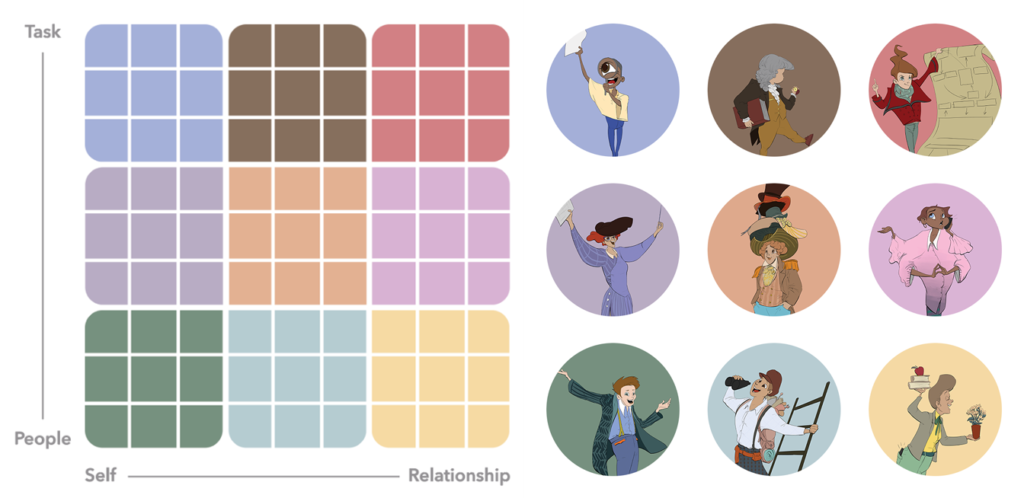The Science Behind Team-Fit & the 9 Team Types
In a realistic work scenario, everyone will have their own preferences and ways of approaching their work. These differences are typically interpreted in the form of personality scales which you can find in our job-fit reports. In order to classify what type of team player a person may be, we further break this down by using a statistical procedure called “factor analysis”.
Factor analysis is a technique used to reduce a large number of variables into fewer numbers of factors. By comparing the similarities and differences, as well as identifying patterns of the sixteen personality traits, we ended up with two main factors that can ultimately determine a person’s team type. Very similar to our job-fit model, these two team-fit factors are also expressed in an “A vs. B” manner, and the results are presented using a low-medium-high scale.
Task vs. Person Focus (TPF)
TPF aims at competencies that are related to an individual’s dynamic attributes and leadership natures. The personality scales that fall into this category include:
- Submissive vs. Assertive
- Group Oriented vs. Self-sufficient
- Outgoing vs. Reserved
| Low TPF | Medium TPF | High TPF |
| More focused on tasks than people; Tend to be self-sufficient introverts and are detail oriented | Energized by both tasks and being around other people, but neither to any excess; Prefers balance | More energized by being around people than by the completion of tasks; Tend to be extroverts, outgoing, and group oriented |
Self vs. Relationship Focus (SRF)
SRF is related to competencies associated with supporting and cooperating behaviors, as well as coping and adapting to change. The personality scales that fall into this category include:
- Conventional vs. Innovative
- Organized vs. Reactive
- Restless vs. Poised
- Excitable vs. Relaxed
- Social Desirability
| Low SRF | Medium SRF | High SRF |
| More focused on the pursuit of personal goals; Tend to be more restless and excitable | Likely to be a flexible individual who likes a balance of pursuing personal goals and relationships | More focused on relationships; Tend to be more reliable and stable |
The 9 Team Types

Prevue’s nine team types are classified by the combination of a person’s TPF and SRF scores. Each colored cell you see represents one of the team characters. For example, someone who scored high on TPF and low on SRF will fall under the green cell, or as we call it the Maverick.
| Detailer
Just as the name suggests, a Detailer’s attention to detail is off the charts. They are very task-focused and prefer to do things by the book, perfect for roles that involve strict rules and standards. |
Realist
A Realist may be quiet and prefer working alone, but they are observant and cautious with every step they take. Their ability to spot the tiniest details is what makes them a great asset to the team. |
Strategist
A Strategist is practical and organized, and live by the phrase, “actions speak louder.” They’re likely the one turning ideas into reality, which makes them a very reliable member of the team. |
| Driver
A Driver has a creative nature and is very goal oriented. They will do anything to ensure a deadline is met, the kind of determination that leads the team to success. |
Chameleon
A Chameleon is generally well-balanced and flexible, the type who tends to ‘go with the flow’ in any situation. They also blend and fit in well wherever needed, just like a chameleon! |
Diplomat
Relationships are very important to a Diplomat. They are a listener and a facilitator. When conflicts arise, they’ll likely make decisions that acknowledge everybody’s strengths and ideas. |
| Maverick
A Maverick is a charmer with an assertive and competitive nature, someone who always aims to win. Their friendliness makes them approachable, and they’ll find themselves fitting in easily. |
Forager
A Forager is very easy-going and also an expert in searching for information and resources. Everyone enjoys being around them and goes to them most when they need help. |
Harmonizer
A Harmonizer enjoys being around people and they love chatting with them. They’re like the social ‘glue’ that keeps their team together, making sure that everyone is happy and conflict-free. |
Learn more about the benefits and use cases of Prevue’s Team-Fit here.